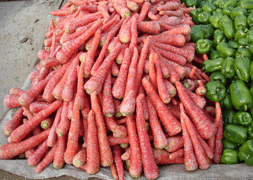Carrots Nutrition Facts
Naturally sugary, delicious and crunchy, carrots are healthy additions that you can make to the vegetable list in your diet. Indeed, these root vegetables come with wholesome health benefiting compounds such as beta-carotenes, falcarinol, vitamin A, minerals and anti-oxidants in ample amounts.
Botanically they are the taproots belonging in the Apiaceae or umbelliferous family of the genus; Daucus. Scientific name: Daucus carota. The other close Apiaceae members include parsnips, parsley, dill, cumin, etc.
 |
 |
| Carrots-Daucus carota, European type. Note for bright orange color and cylindrical shape. |
Note for different color carrots! Photo courtesy:wordridden |
Carrot plant is cultivated across the world for its prized taproot. It is biennial and bears flowers during second year of life. However, in general, the whole plant is harvested much prematurely without wait for the bloom when its root reaches about an inch in diameter, tender and juicy.
 |
| Asian (oriental) variety. Note for Saffron red color and tail like tapering lower ends. |
Carrots vary widely in color and shape depending on the cultivar types. Generally, oriental taproots are long, featuring flat upper end with tapering, tail like, lower ends. They are winter season crops in many parts of Asia.
European carrots, on the other hand, have more rounded ends with almost cylindrical body. In addition, European-variety feature bright orange color in contrast to saffron colored Asian cultivars.
Health benefits of carrots
-
Sweet and crunchy carrots are notably rich in anti-oxidants, vitamins and dietary fiber. They provide only 41 calories per 100 g, negligible amount of fat and no cholesterol.
-
They are exceptionally rich source of carotenes and vitamin-A. 100 g fresh carrot contains 8285 µg ofbeta-carotene and 16706 IU of vitamin A. Studies have found that flavonoid compounds in carrots help protect from skin, lung and oral cavity cancers.
-
Carotenes are converted into vitamin A in the liver. Beta-carotene is the major carotene that is present in these roots. Beta carotene is one of the powerful natural anti-oxidant that helps protect body from harmful oxygen-free radical injury. In addition, it also has all the functions of vitamin A such as maintaing good eye health, reproduction (sperm production), maintenance of epithelial integrity, growth and development.
-
Carrots are rich in poly-acetylene antioxidant, falcarinol. Research study conducted by scientists at University of Newcastle on laboratory animals has found that falcarinol in carrots may help fight against cancers by destroying pre-cancerous cells in the tumors.
-
Fresh roots are also good in vitamin C; provide about 9% of RDA. Vitamin C is water soluble anti-oxidant. It helps the body maintain healthy connective tissue, teeth and gum. Its anti-oxidant property helps the human body protect from diseases and cancers by scavenging action on harmful free radicals.
-
In addition, they are especially rich in many B-complex groups of vitamins such as folic acid, vitamin B-6 (pyridoxine), thiamin, pantothenic acid, etc., that acts as co-factors to enzymes during substrate metabolism in the body.
-
Further, They also compose healthy levels of minerals like copper, calcium, potassium, manganese and phosphorus. Potassium is an important component of cell and body fluids that helps controlling heart rate and blood pressure by countering effects of sodium. Manganese is used by the body as a co-factor for the antioxidant enzyme, superoxide dismutase.
| Principle | Nutrient Value | Percentage of RDA |
|---|---|---|
| Energy | 41 Kcal | 2% |
| Carbohydrates | 9.58 g | 7% |
| Protein | 0.93 g | 1.5% |
| Total Fat | 0.24 g | 1% |
| Cholesterol | 0 mg | 0% |
| Dietary Fiber | 2.8 g | 7% |
| Vitamins | ||
| Folates | 19 µg | 5% |
| Niacin | 0.983 mg | 6% |
| Pantothenic acid | 0.273 mg | 5.5% |
| Pyridoxine | 0.138 mg | 10% |
| Riboflavin | 0.058 mg | 4% |
| Thiamin | 0.066 mg | 6% |
| Vitamin A | 16706 IU | 557% |
| Vitamin C | 5.9 mg | 10% |
| Vitamin K | 13.2 µg | 11% |
| Electrolytes | ||
| Sodium | 69 mg | 4.5% |
| Potassium | 320 mg | 6.5% |
| Minerals | ||
| Calcium | 33 mg | 3% |
| Copper | 0.045 mg | 5% |
| Iron | 0.30 mg | 4% |
| Magnesium | 12 mg | 3% |
| Manganese | 0.143 mg | 6% |
| Phosphorus | 35 mg | 5% |
| Selenium | 0.1 µg | <1% |
| Zinc | 0.24 mg | 2% |
| Phyto-nutrients | ||
| Carotene-α | 3427 µg | -- |
| Carotene-ß | 8285 µg | -- |
| Crypto-xanthin-ß | 0 µg | -- |
| Lutein-zeaxanthin | 256 µg | -- |
Selection and storage
 |
| Fresh carrots and green bell peppers in a market. |
Fresh carrots are available in the markets around the season. While buying, look for young, tender, bright-colored roots with firm consistency. Avoid soft, flabby roots, with cuts or mold. Furthermore, avoid very large-sized roots as they are indication of over maturity; ensuing poor eating quality.
Undue exposure of carrot to sun light would result in greenish discoloration near its top end because of chlorophyll photo-pigment deposition. Although this may not affect on health badly, however, the condition may diminish its sweet taste. Avoid forking or twisting carrots as they may be the indication of either disease infestation or close crop cultivation.
Once at home, wash them thoroughly in cold water to remove dust, soil, or insecticide/fungicides. Generally, the top greens are severed from the root before storing in the vegetable compartment of the refrigerator where they keep well for 1-2 weeks. Set refrigerator temperature level below 35 degree F and high humidity to maintain vitality.
Preparation and serving methods
Wash carrots thoroughly before use. Trim both ends; gently scrape off outer skin and smaller hairy roots. The younger roots have crispy, pleasant taste with rich flavor. Raw carrots are naturally sweet and juicy; however, boiling them in water for few minutes enhances the bioavailability of nutrients.
Here are some serving tips:
- Fresh carrots can be enjoyed as they are, or can be used raw in vegetable as well as fruit salads.
- Its slices easily blend with other common root vegetables like radish, beets, kohlrabi, turnips or with greens/tomato in mixed salads.
- Carrot juice is a refreshing drink, enjoyed either alone or with fruit/vegetable juice.
- Carrots mix well with vegetables like green beans, potato, peas in variety of recipes either stewed, in curry, stir fries, etc.
- In South Asia, delicious sweet dish, "gaajar ka halwa," is prepared using grated carrot, almonds, cashews,pistachio, butter, sugar, and milk.
- The root is also used in the preparation of cakes, tart, pudding, soups, borscht, etc.
- They are also used in the preparation of healthy baby-foods.



